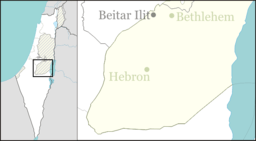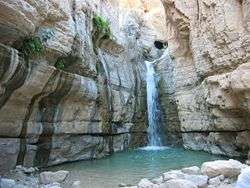Pnei Kedem
Pnei Kedem (Hebrew: פְּנֵי קֶדֶם), is an Israeli outpost attached to the Israeli settlement of Metzad in the southeastern part of the Gush Etzion settlement bloc in the West Bank. It is located near Si'ir in the eastern Judean Mountains at Nahal Arugot (the Arugot Stream).Pnei Kedem at an elevation of 930 metres above sea level, 14.5 km from the Green Line, outside the Separation Barrier.
Pnei Kedem פְּנֵי קֶדֶם | |
|---|---|
View to the east of Pnei Kedem towards the Dead Sea | |
 Pnei Kedem | |
| Coordinates: 31°35′18″N 35°11′45″E | |
| Country | Israel |
| District | Judea and Samaria Area |
| Council | Gush Etzion |
| Region | West Bank |
| Founded | 2000 |
| Founded by | Amana |
| Population (2011) | [1] |
| Website | http://www.pneikedem.org/ |
The international community considers all Israeli settlements in the West Bank illegal under international law, but the Israeli government disputes this.[2]
History
The outpost was built in October 2000 with assistance from Amana within the boundaries of the nearby Israeli settlement of Metzad and on adjacent lands. In 2003, Pnei Kedem was given the status of a permanent township without being legalized, receiving lighting and other services from the Israeli Defense Ministry, despite the Israeli government's pledge in the Road Map to remove illegal outposts.[3]
Pnei Kedem holds an annual kite festival during Chol HaMoed Sukkot which attracts thousands of participants.
In November 2007, Haaretz reported that a settler of Pnei Kedem complained that he had 500 olive tree saplings uprooted by Palestinians.[4]
As reported by The Jerusalem Post in 2008, settlers from Pnei Kedem receive "counterterrorism training" from the organization Mishmeret Yesha in "how to quickly neutralize terrorist infiltrators".[5] In September 2011, before the Palestinian Authority's statehood bid at the United Nations, Arutz Sheva published photographs of women from Pnei Kedem being trained with firearms and live ammunition.[6][7][8]
The population of Pnei Kedem receives its municipal services from the Gush Etzion Regional Council, which lists it on its official website as a separate community. But as Israeli authorities do not recognize the outpost as an independent settlement, the Israel Central Bureau of Statistics counts its residents as living in Metzad. According to Arutz Sheva, Pnei Kedem was home to 32 families in 2011 and absorbing new residents.[9]

References
- "Locality File". Israel Central Bureau of Statistics. 2011. Archived from the original (XLS) on September 23, 2013. Retrieved February 2, 2013.
- "The Geneva Convention". BBC News. 10 December 2009. Retrieved 27 November 2010.
- "Defense Ministry to provide services to illegal outposts". Haaretz. October 27, 2003. Retrieved April 19, 2013.
- Nadav Shragai (November 20, 2007). "Settlers accuse Palestinians of vandalizing Jewish farms". Haaretz. Retrieved April 19, 2013.
- Matthew Wagner (April 4, 2008). "Jews with guns". The Jerusalem Post. Retrieved August 30, 2012.
- Harriet Sherwood (24 September 2011). "While the diplomats haggle, deadly tensions are mounting in the nascent Palestine". The Observer.
- Chana Ya'ar (September 22, 2011). "PA Arab Riots in Beit Ummar as UN Statehood Bid Approaches". Arutz Sheva. Retrieved April 19, 2013.
- Gil Ronen (September 22, 2011). "Judean Women Look Through the Crosshairs". Arutz Sheva. Retrieved April 19, 2013.
- "New Torah Scroll in Pnei Kedem". Arutz Sheva. May 10, 2011. Retrieved April 19, 2013.